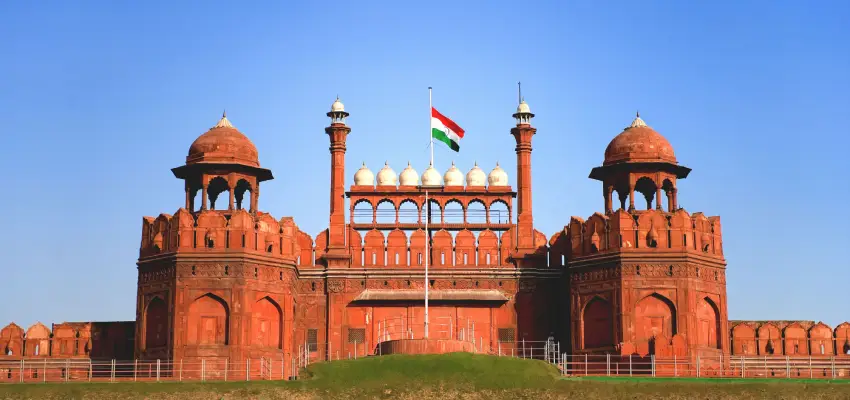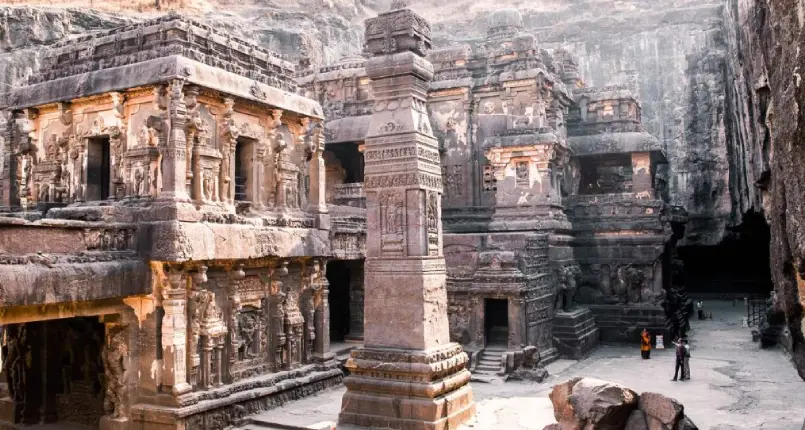
Golden Triangle with Ajanta and Ellora Caves Tour Package
Duration
10 Nights / 11 Days
Tour Type
Heritage Tour
Region
North and West India
Destinations
Delhi, Agra & Mumbai
The Golden Triangle Tour is a unique journey that allows one to experience India’s culture, history, and architecture in Delhi, Agra, and Jaipur. By enabling the tourists to visit India’s picture-perfect places, this hertiage tour of India showcases the finest of Indian culture and tradition. This package includes the extension tour to Ajanta and Ellora caves, located near Aurangabad, Maharashtra. It is one of the most famous UNESCO world heritage site allows the traveler to admire an impressive ancient Indian rock-cut architecture and Hindu, Jain and Buddhist art.
On this grand tour, one can experience the royal aspect of India as well as the spirituality of the ancient times. This tour is suitable for tourists who have an extensive time to break and explore the culture of India. What one can witness in this trip is not just the great historic palaces of Jaipur or the ancient caves of Ajanta and Ellora but perhaps the essence of Indian culture and its diversity.
Features of Golden Triangle with Ajanta Ellora Caves
As the name suggests, Golden triangle tour is the tour connecting 3 cities in India that are a must visit- Delhi, Agra, and Jaipur. Delhi is the initial stop of the journey and here one is offered the opportunity to visit both ancient and modern structures. Tourists will visit places such as the Red Fort, Qutub Minar and India Gate and many other market parts in Old Delhi. In the next phase, the visitors will head to Agra and view the Taj Mahal which is among the seven wonders of the world and the Agra Fort and other Mughal relics.
While in Jaipur, the “Pink City,” experience India’s regal past by visiting the beautiful Amber Fort, the lovely City Palace, and the extraordinary Hawa Mahal (Palace of Winds) structure. All these cities give this kind of experience of Indian royal family and traditions which are so different.
Golden Triangle with Ajanta and Ellora Caves Tour
With Golden Triangle of India with Ajanta and Ellora Caves Tour, tourist can travel to historic caves of Aurangabad. These are situated close to Aurangabad in Maharashtra are among India’s most superior works of ancient art who are patronized by God. The Ajanta Caves are notable for their Buddhist monastic caves carved out of rock, embellished with beautiful murals, sculptures, and bas-reliefs that depict scenes of ancient monastic life. The Ellora Caves, on the other hand, comprise a blend of Hindu, Jain and Buddhist temples cut into the rocks of the mountains. Another spiritual site, The Kailasa Temple at Ellora, cut out of a single stone, is a masterpiece of Indian Art.
This Golden Triangle with Ajanta and Ellora Caves Tour Package not only include the best cultural hotspots of India but breathtaking rock-hewn temples and monasteries of Maharashtra as well. For anyone interested in history, art and spirituality, religious decor and architecture of India in general, it is a very eye-opening and astonishing tour.
Itinerary
Day 1 – Arrival at New Delhi
Arrive in the capital city Delhi (at Indira Gandhi International Airport) by international flight, where you are welcomed with traditional Indian ‘Swagat’ (welcome). From the airport you are transferred by our representatives to the hotel for check in and overnight stay at hotel in Delhi.
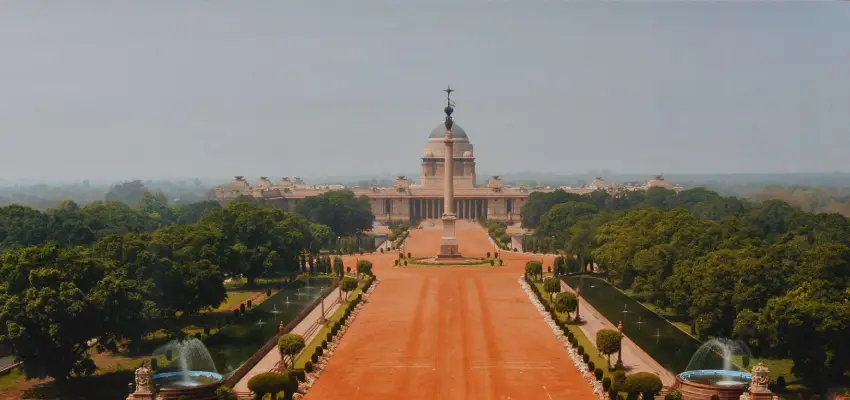
Day 2 – Delhi Sightseeing
After breakfast at the hotel. leave on a guided tour of Delhi. The sightseeing trip starts with Old Delhi and we pay short visits to the Red Fort (built in 1648), Jama Masjid (India’s largest mosque) and Raj Ghat (Mahatma Gandhi’s Memorial). After lunch, we visit India Gate, President’s House, Humayun’s Tomb, and Lotus Temple. The overnight stay is provided at hotel.
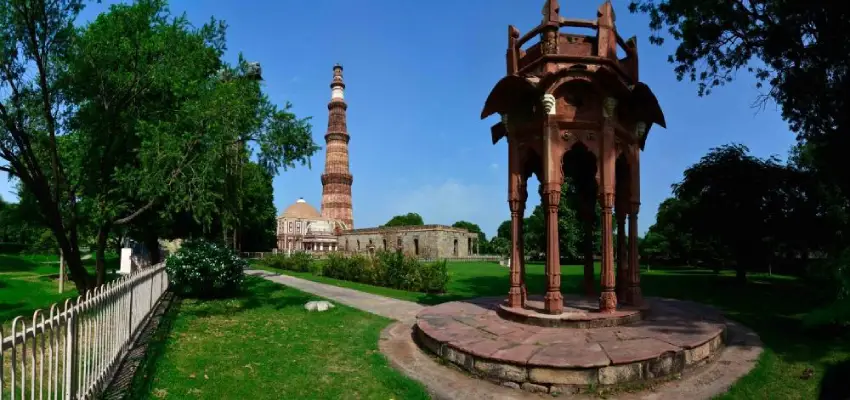
Day 3 – Delhi – Agra (about 180 km)
Today, we spend a couple of hours to the highest brick minaret in the world – ‘Qutab Minar’ (71 m). The construction of this five storeyed building started in 1199, and it was damaged twice and repaired in 1326 and 1368. After completing sightseeing at Delhi, we travel to Agra and stay overnight in the hotel at Agra.
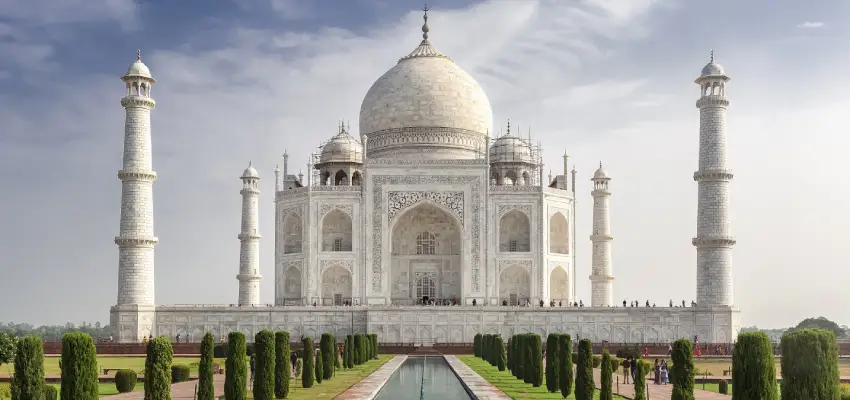
Day 4 – Agra Tour
After Breakfast our sightseeing trip starts with the Agra Fort. Mughal Emperor Akbar laid the foundation of this majestic fort in 1565, and was later completed by his grandson Emperor Shah Jahan. The next halt is the most beautiful and spell binding wonder of the world – the Taj Mahal. The symbol of love (built in pure white marble by emperor Shah Jahan as a promise to his beloved wife Mumtaz Mahal) We You may spend the evening visiting the local artisans & watch them do fine marble inlay work. Overnight at the hotel in Agra.

Day 5 – Agra – Fatehpur Sikri – Jaipur
After Breakfast, check out & travel towards Jaipur, the land of the Rajput Royals, en-route stopping at the 16th century historical town Fatehpur Sikri. The capital of the Mughals is popular for its red sandstone edifices. We reach Jaipur in the afternoon, and after some rest at the hotel, we continue our exploration with the City Palace (the formal residence of the Jaipur royal family). Showcasing a perfect blend of the Hindu and Mughal architectural patterns. this complex houses a museum with a rare collection of the artifacts belonging to the erstwhile royal families. Our last halt for the day is Jantar Mantar, This stone observatory was built by Maharaja Sawai Jai Singh.
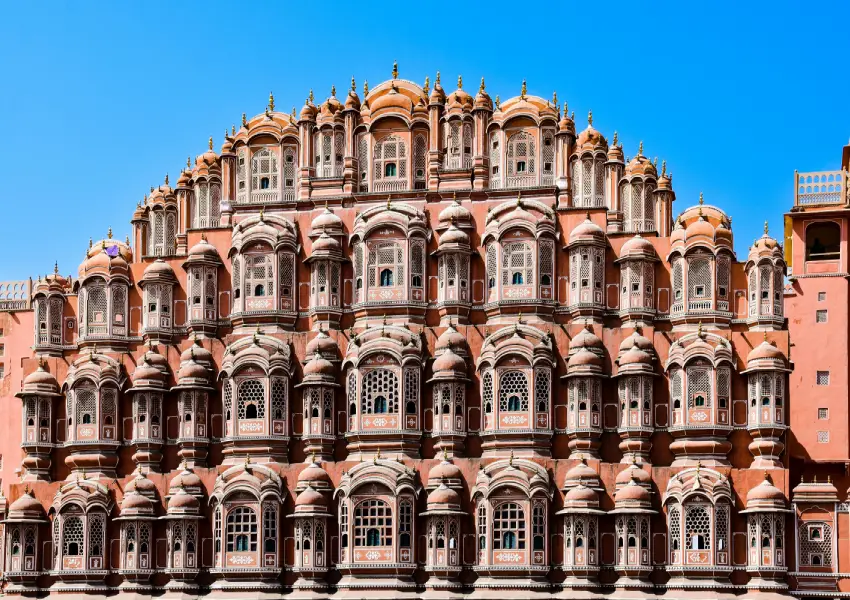
Day 6 – Jaipur Tour
Today we have breakfast in the hotel and then we drive to the ancient capital of Amber that is located at a close proximity to Jaipur (11 km). In ancient times, Amber served as the capital of the Kachhawaha dynasty for 6 centuries. The journey to the Palace Fortress is best covered while riding an Elephant. Enroute we will visit the Hawa Mahal (Palace of the Winds). This red sandstone architectural wonder, built in 1799 AD, has 953 casements / windows. We visit the colourful market area of Jaipur in the afternoon. A visit to a factory to see the famous block printing work will refresh your senses. We also pay a short visit to the ‘Laxmi Narayan Mandir’ in New Jaipur City in the evening. This famous Hindu temple is made of pure white marble. Today we have dinner while enjoying the live performances of traditional Indian music and dance. Overnight at hotel in Jaipur
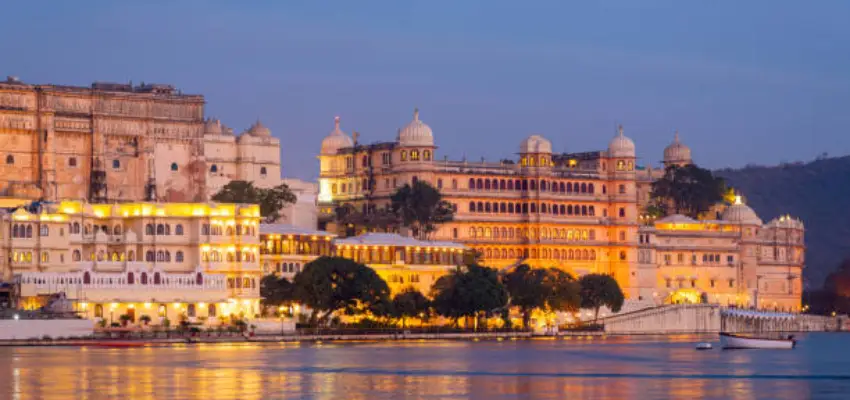
Day 7 – Jaipur – Udaipur (by air)
Take morning flight to Udaipur, the city of lakes. After some refreshments, we start our sightseeing with Sahelion-Ki-Bari or the Garden of the maids of Honour. After visiting the extensive lawns of Sahelion ki Bari, we head towards the Museum of traditional folk art, showcasing a rich assortment of folk dresses, ornaments, puppets, masks, toys, folk musical instruments and paintings. Then we stop for a quick meal at a restaurant and proceed to the City Palace. It claims of being the biggest palace in India, where four generations of Rajput kings added their contribution. The museum of the palace is adorned with beautiful peacock mosaic and tiny wall paintings that depict stories from Indian folklore. Experience an opportunity to see making of these famous miniature paintings at a traditional painting school. In the evening enjoy a Boat ride on the lake Pichola. The famous Lake Palace inside the Lake Pichola was the summer residence of the erstwhile rulers. Overnight at hotel in Udaipur

Day 8 – Udaipur – Mumbai (by air)
This morning, we fly to Mumbai – the city of dreams, the city synonymous with films, a city of contrasts. This biggest commercial city of India and is frequented for its temples, cathedrals, mosques and the best of cosmopolitan culture. While walking along the harbour area, we see the Gateway of India. The 1927 old structure was built by the English to honour the visit of George THE 5th from England. In the evening, we take a trip to the Gandhi Museum and Hanging Garden. Overnight at hotel in Mumbai
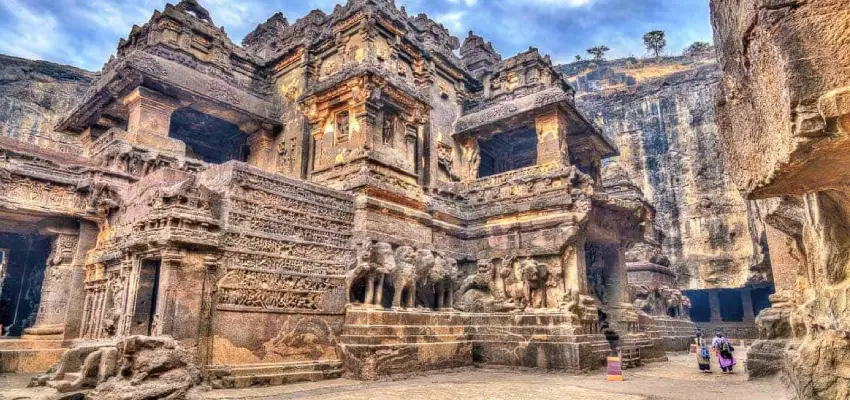
Day 9 – Mumbai – Ellora – Aurangabad (by air)
After Breakfast Board Flight to Aurangabad. Transferred to hotel and later excursion to the famous Ellora Caves. [7th – 10th century A.D.] The wonderful group of rock temples of Ellora is listed as part of world heritage monuments. The Ellora group of temples embodies the art and sculptures of Buddhism, Hinduism and Jainism – three foremost religions of India. Overnight at the hotel in Aurangabad.
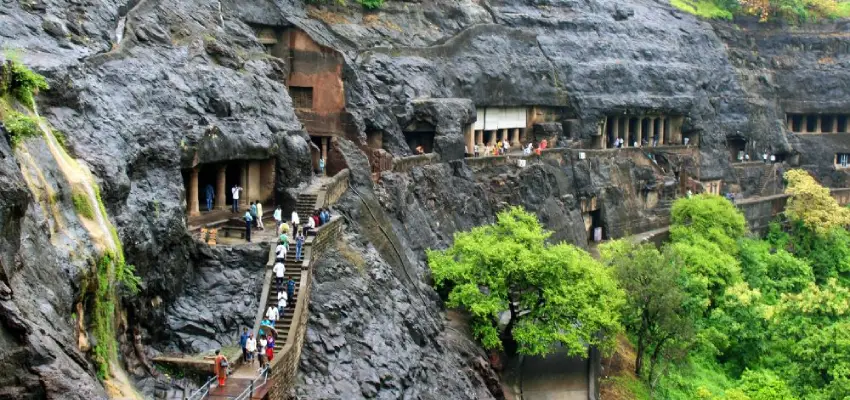
Day 10 – Aurangabad – Ajanta – Aurangabad
After breakfast we travel to Ajanta caves (around 100 km.) Of the 30 monuments at Ajanta, 4 caves No. 9,10,26 and 29 are sanctuaries or Chaitya containing a Stupa at the centre of their apsis. The others are monastic residences or Viharas. Indian poet Kalidasa defines these caves as the gem set of jewellery, rich furniture, striking architecture, with natural backdrop and leaving inspiring expressions on the faces. overnight stay at hotel at Aurangabad
Day 11 – Aurangabad – Mumbai – Departure
Today we fly from Aurangabad to Mumbai.
Tour concludes: SOS travel house thanks you for your patronage and ensures a great experience of holiday in India.
Whats Included

Pick-up & Drop
Inclusive facility of Pick-up and Drop

Meals
10 Breakfast at respective hotels
1 Lunch

Accomodation
2 Night Stay at Hotel in Delhi
2 Night Stay at Hotel in Agra
2 Night Stay at Hotel in Jaipur
1 Night Stay at Hotel in Udaipur
1 Night Stay at Hotel in Mumbai
2 Night Stay at Hotel in Aurangabad

Taxes and Concierge
Taxes and concierge services

Local Guides
Professional guides in chosen language

Destination Transfers
Airport transfers ( By chosen vehicle)
Sightseeing transfers ( By chosen vehicle)
Whats Excluded

Insurance
Travel Insurance

Meals
As per itinerary

Monuments Fees
Monuments and sightseeing entrace fees

Domestic & International Airfares
Not Includes
Tour Highlights
- Delhi: Red Fort, Jama Masjid and Raj Ghat, India Gate, President’s House, Humayun’s Tomb, and Lotus Temple, Qutab Minar
- Agra: Taj Mahal, City Tour
- Fatehpur Sikri: Fatehpur Sikri Fort
- Jaipur: City Palace, Jantar Mantar, Amber Fort, Hawa Mahal (Palace of the Winds), Laxmi Narayan Mandir
- Udaipur: Sahelion ki Bari, Museum of traditional folk art, Cultural Tour, City Palace, Lake Palace,
- Mumbai: Gateway of India, Gandhi Museum and Hanging Garden
- Aurangabad: Ajanta and Ellora Caves (Buddhism, Hinduism and Jainism)
Private & Custom Tours
These tours can be customized for you to suit your needs.
Frequently Asked Questions
Where is Ajanta and Ellora Cave located?
The Ajanta and Ellora Caves are situated nearby the city of Aurangabad in the Indian state of Maharashtra. The Ajanta Caves, located about 100 kilometers away from Aurangabad, and the Ellora Caves, positioned approximately 30 km from the city, are both UNESCO World Heritage Sites that are prominent for magnificent rock-cut architecture, elaborate carvings, and paintings that can be traced back to the 2nd century bc or the early years of the Common Era.
What is the best time to visit Ajanta and Ellora Caves?
From October to March month, the weather is quite cool and pleasant, tourist can plan their holiday in India during this period.
What are the Ajanta and Ellora Caves?
They are ancient rock-cut caves with carvings and paintings located in Maharashtra, India.
Who built the caves of Ajanta and Ellora?
One of the earliest construction work at the Ajanta Caves, which are elaborate rock-cut temples in India, can be traced to around the 2nd century BC under the Satavahana dynasty, and is attributed to Buddhist monks and builders. Particularly during the 5th century, many of the caves were redecorated and enlarged to become more in line with Buddhist ideals in the fashion of monastic Buddhist life, thanks to the Gupta empire.
On the other hand, the construction of Ellora Caves, which spanned from the 6th to the 10th century CE, had multireligious influences, namely, Buddhism, Jainism, and Hinduism. Strikingly, the majority of the Hindu caves including Kailasa Temple (Cave 16) were built around the era dominated by the Rashtrakuta dynasty. This era witnessed the development of both Buddhist and Jain caves by local rulers who used to fund and built each faith’s temples, thus boasting construction craftsmen, monks, and devotees of this time.

